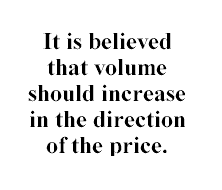After looking at the various chart patterns explained so far, you'll notice that consideration has been given to volume. Simply put, volume is the number of contracts traded over a period of time. And since even the most reliable of patterns will fail sometimes, volume can be used as another tool in determining what's happening within the market and more specifically what's happening within the pattern.
It is believed that volume should increase in the direction of the price.
If the prevailing trend is up, volume should be heavier on the up days
and lighter on the the down days. If the trend was down, volume should be
heavier on the down days, with ligh One of the reasons why volume has a tendency to diminish during periods of indecision is for just that reason. During periods of sideways movement, often traders will avoid a market, preferring to commit their funds once a clear-cut breakout is seen. However, while it's typical for volume to diminish during these times, volume can give clues as to possible future direction by measuring the level of conviction of the buyers and the sellers. Seeing if there's heavier volume on the up days or on the down days could be useful in getting positioned during a sideways move or a formation of a pattern. The idea being that if there's more volume on the up days than the down days, the buyers are probably the more aggressive and the market should more than likely breakout to the upside. The reverse being true if the volume is heavier on the down days, with the market likely to breakout to the downside. So while it seems as if chart patterns, volume and technical analysis in general all have some forecasting abilities, none are foolproof. Used together, they can be quite helpful in your trading and investing, but should be looked at more as helpful hints as to a markets bias, more than anything else.
Futures and options trading carries significant risk and you can lose some, all or even more than your investment. Stock trading involves high risks and you can lose a significant amount of money. The information contained here was gathered from sources deemed reliable, however, no claim is made as to its accuracy or content. This does not contain specific recommendations to buy or sell at particular prices or times, nor should any of the examples presented be deemed as such. There is a risk of loss in trading futures and futures options and stocks and stocks options and you should carefully consider your financial position before making any trades. The reference to statistical probabilities does not pertain to profitability, but rather to the direction of the market. The size and the duration of the markets move, as well as entry and exit prices ultimately determines success or failure in a trade and is in no way represented in these statistics. This is not, nor is it intended to be, a complete study of chart patterns or technical analysis and should not be deemed as such.
|
 ter volume on the up days. This makes
sense because in an uptrend there should be more buyers than sellers, and in
a downtrend there should be more sellers than buyers. If volume should start
to diminish, it could be a warning that the trend could be losing steam and
that a consolidation or perhaps a reversal could be ahead. If
the trend was up, and now we're seeing more volume on dips than on rallies,
it should be an alert that buying pressure is waning and sellers are
becoming more aggressive. The reverse would be true in a downtrend. If
volume starts to shrink on the sell-offs and picks up on the rallies, once
again, it could be a sign that the trend is in trouble, and buyers are
starting to assert themselves. When volume moves in the opposite direction
of the price, this is called divergence.
ter volume on the up days. This makes
sense because in an uptrend there should be more buyers than sellers, and in
a downtrend there should be more sellers than buyers. If volume should start
to diminish, it could be a warning that the trend could be losing steam and
that a consolidation or perhaps a reversal could be ahead. If
the trend was up, and now we're seeing more volume on dips than on rallies,
it should be an alert that buying pressure is waning and sellers are
becoming more aggressive. The reverse would be true in a downtrend. If
volume starts to shrink on the sell-offs and picks up on the rallies, once
again, it could be a sign that the trend is in trouble, and buyers are
starting to assert themselves. When volume moves in the opposite direction
of the price, this is called divergence.